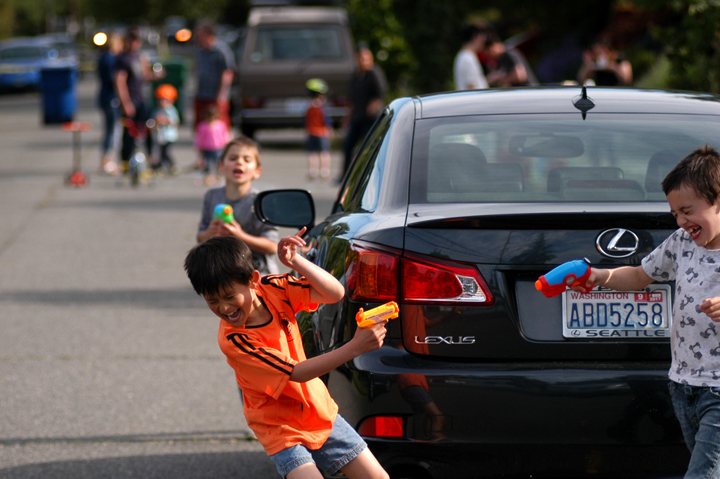
Photo:
A Play Street in North Seattle. Photo by JiaYing Grygiel
Some of my favorite childhood memories are the hours my sisters and I spent playing outside, on and around the dead-end street where we lived. Our playmates? Whoever was around. The road, driveways and yards were ours.
Sound like a nostalgic dream from days gone by? Not in Seattle. In 2014, the city’s Department of Transportation launched a pilot project called Play Streets, which grew out of a Department of Transportation task force that looked at ways to better use one of the biggest sources of public space in the city — streets. Rooted in the Neighborhood Night Out tradition of block parties, Play Streets allows city residents to apply for a permit to shut down a specific, non-arterial block for up to six hours at a time, up to three times a week.
"It's important to have open spaces where we can play and get to know each other," says says Brian Henry, a Seattle Department of Transportation program development supervisor who's worked on the program. Plays Streets is a great example because it can happen in nearly every neighborhood.
Henry has been pleased with how Play Streets has grown — 350 people have applied for permits since the program began. And it’s equitable, essentially creating a pop-up park in neighborhoods that might not have access to close-by green space. You can even apply for a permit for a street that you don’t live on. And the program is open all year (there are two cycles of applying for six-month permits).
What are the secrets of a successful Play Street? We talked to organizers and experts to get top tips.

1. Start with Neighborhood Night Out
If you've been thinking about starting a Play Street, an annual Neighborhood Night Out street block party (Tuesday, Aug. 1 this year) is a good time to check in with neighbors about their interest. Apply for a permit to shut down your street for a Night Out party on Seattle's Night Out website to apply for an application, put your event on the map and get tips.
2. Get buy-in with neighbors
Proponents say the program works best when the street is non-arterial with low volumes of traffic and there are enough interested families who live on or near the street. Neighbor support is critical. As part of the application process, the Play Streets program recommends that organizers do things like put up flyers, go door to door and even gather signatures from neighbors to show their support. (See the website for tips, and this extensive manual.)
Kristina Bernhardt, who has helped organize a Play Street in Seattle's Maple Leaf neighborhood, cites several tactics her street has used to get interest in Play Streets, including distributing flyers every year before it starts and posting reminders on a neighborhood Facebook page. They also make sure people know Play Streets is for everyone, not just for kids.
“I do love the name 'Play Streets,'" says, "but I do think a lot of people think it’s just for kids. Adults without kids are welcome, too.”

3. Be prepared for pushback
"Be aware that there will be some people who will be upset and be prepared to have that conversation," Bernhardt. “We say it’s important for kids to have a safe place right by home to play, like we used to. it’s about the kids and building community.”
If some neighbors and drivers are still unhappy, she encourages them to contact folks at Seattle's Play Streets program.
4. Have shared ownership
The more families on the street who are involved in organizing, hosting and monitoring a Play Street, the more chance it has of success. Layna Mosich, who organized a Play Street last fall during the day for her 5-year-old son and other neighborhood kids, found shared ownership a challenge. Because many kids on their street were not available during the day, she ended up inviting friends from other neighborhoods, which put her in the position of having to play sole host (which included managing barricades, facilitating bathroom use, providing snacks and Band-Aids, etc.)
"That's fine for playdates, but it was too much for every Play Street." She continues to be enthusiastic about the program, but isn't currently organizing one for her street.
5. Have a consistent time
Many weekly Play Streets are on a consistent day and time of the week, which makes it easier for neighbors to remember it's happening. That's worked well for Bernhardt’s street: “You start training the people around you — don’t go down [that street] on that day,” she says. And even if they know there will be low attendance, they’ll have it on the same day, to keep the ritual.
6. But flexibility can work, too
While a consistent day is simpler, some Play Street organizers will use the flexibility of the program (you can apply for a permit for up to three days a week) to decide when to have it, based on weather and schedules. "Let’s pretend you have a the permit for Tuesday, Thursday and Saturday," says Rob Johnson, Seattle city councilmember and Play Street champion. "This gives you the flexibility to close [the street] on the day when the weather is nice."
7. Set up a communication system
Have a method to remind neighbors of the scheduled closure. Kristina Bernhardt's street has a neighborhood Facebook group. Wendy Law, who organizes a Play Street in Greenwood, says they have a shared Google calendar they put Play Streets on, once they've decided on a day (they have a permit for three days a week). "We add neighbors as they want to be added to it."
8. Be clear about the rules
How will you let kids know when a car is coming through? Is it OK for kids to go into neighbors' yards and houses? Having clear rules for kids and then working together to enforce them is helpful. A key element of the Play Street in Berhardt's neighborhood is a whistle: It's blown when a Play Street starts, and then, during the event, when a car is coming through. "Kids know that when they hear a whistle, a car is coming and they need to move out of the way."
Another rule is that kids to stay outside, in front yards and on the streets. "If they need to use a neighbor’s bathroom, they let their parents know."
9. Get the right barricades
Play Streets need to have barricades in place to halt traffic and keep people safe. SDOT's Play Streets manual has specific requirements for barricades based on the street classification, and it's also required to have an adult near a barricade to monitor it.
Seattle city councilmember Johnson recommends multiple barriers, including signs and actual barricades: Visual and physical barriers can cut down on questions from drivers."
10. Plan a few activities at the start
We all want kids to just naturally play together, without any adult help, but sometimes — especially if it’s a new concept, like playing in the street, or with new people, a little nudge can go a long way. Have props like scooters, chalk and a Frisbee at the ready and consider teaching an old-school game or two.
“I do think it’s good to have a catalyst or activity that kids understand that streets are a place to play like their yard. Then they can bring their own creativity,” says Henry of SDOT. SDOT's Play Street manual includes several examples of organized activities, such as a water gun battle, or bike rodeo.
More resources for planning a Play Street, block party or Night Out event |











